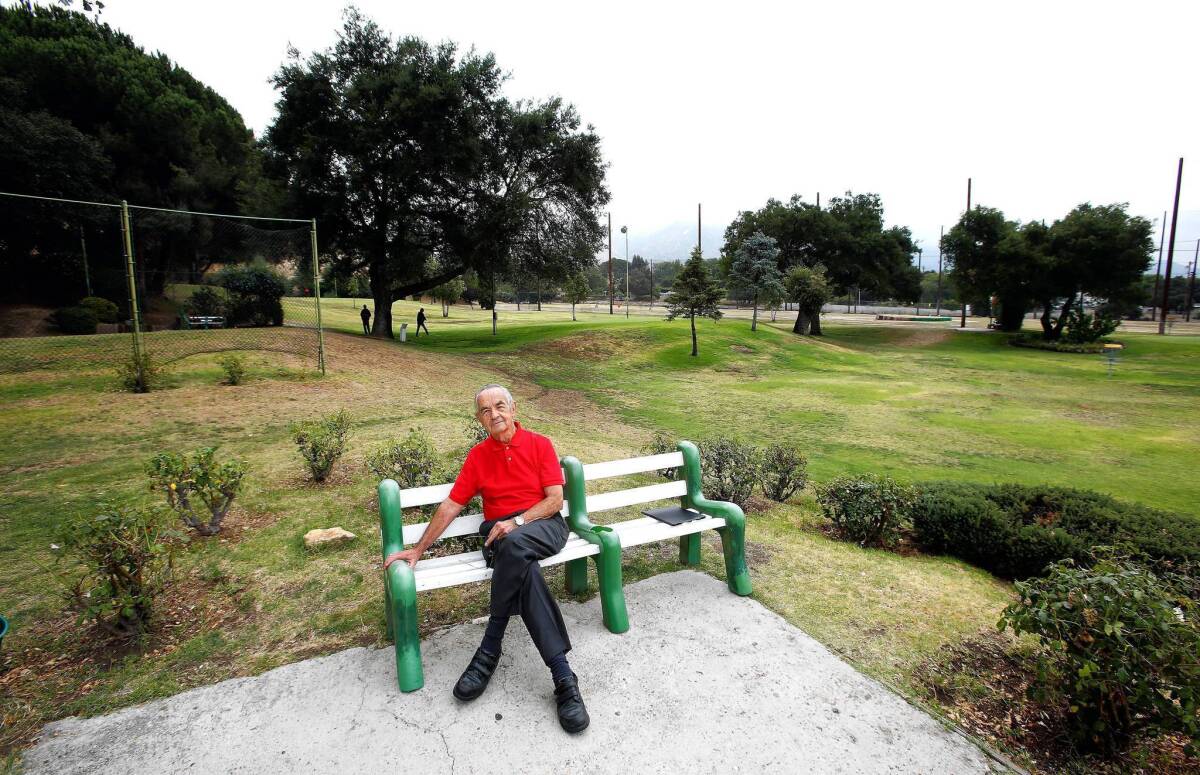Can part of a golf course win historic designation?

- Share via
Motorists whizzing by an oak-studded canyon off the 210 Freeway near Tujunga might know it as the Verdugo Hills Golf Course. But to Lloyd Hitt, 81, a retired Sunland pharmacist who fights to preserve the area’s historic structures, it’s his toughest battleground ever.
During World War II, part of the 30-acre golf course housed more than 2,000 “enemy aliens,” mostly adult male Japanese immigrants taken from their homes after Japan’s attack on Pearl Harbor. They were temporarily housed in what was known as the Tuna Canyon Detention Station, before being sent to internment camps.
In 17 years of volunteer work with the Little Landers Historical Society, Hitt saved several structures in his Sunland-Tujunga foothills community. But he and other preservationists faced tough odds when they set out to have a portion of the golf course set aside for historic recognition and protection.
The detention station, which operated from December 1941 to late 1943, was long gone. A watchtower, warehouse-style barracks and 12-foot barbed-wire perimeter fence had been razed decades ago. What was there to designate?
The property’s new owner, Snowball West Investments, was pressing ahead with a plan to replace the golf course with 229 single-family homes. Company officials worried that a historic designation would interfere and hired a City Hall lobbyist to fight it. Hitt was running out of time.
::
Haru Kuromiya struggles to recall details of the 1942 spring day when, as a 15-year-old, she went to the Tuna Canyon Detention Station, hoping to see her father. A Riverside vegetable farmer, Chikayasu Inaba was removed from the family’s home in the middle of the night by FBI agents, said Kuromiya, now 86 and living in Altadena.
Her father and an uncle were being held inside the Tujunga outpost that she, her mother and her aunt were determined to visit, Kuromiya recalled. Refused entry, they spotted her father and shouted through the fence, she said.
“So much of that period I think I just blocked out,” she said. “I missed my dad a lot. I really felt his absence. So I was really glad to see him.” To her relief, he appeared to be healthy and well cared for. Eventually, Kuromiya’s entire family was interned at Crystal City camp in Texas.
Archival documents on the Tujunga center show that detainees, under federal immigration officer Merril H. Scott, governed themselves, elected a “mayor” and decided how to staff the commissary. They also took turns tending a community garden and preparing food for the detainees.
Black-and-white photographs show neatly groomed Japanese men playing horseshoes next to the barbed wire fence. In one, a watchtower looms over the camp.
Another document details the location of the camp’s seven barracks, a mess hall, two administrative buildings and an infirmary.
For six years, Hitt had no idea the photographs existed. He had collected many public documents and government reports on the camp. But he lacked humanizing photographs of daily life in the center, which left a big hole in his push for historic recognition, he said.
Then, in mid-January, a young stranger called. David Scott said he was the grandson of Merril Scott, the former detention center commander. “I’ve got an album,” he told Hitt. “Do you want it?”
The thick binder was stuffed with camp photographs, drawings by detainees and letters that those confined to the station had written Scott’s grandfather, thanking him for his management of the center. It also included Merril Scott’s reports to his superiors.
Hitt, recalling the discovery during a visit to the golf course, had to pause to compose himself. “Sorry,” he said, wiping his eyes. “It gets harder as I get older. I couldn’t believe it. It was like discovering gold.”
After bringing Hitt copies of everything he had, David Scott, who runs an Upland cleaning company, joined the push for the historic designation. His grandfather “had a job to do and he made the best out of a bad situation for everybody,” he said.
::
The photos helped. The L.A. City Council, led by then-Councilman Richard Alarcon, agreed to back a request for a historic designation for a portion of the golf course. But in mid-April, the city Cultural Heritage Commission unanimously rejected the proposal, citing the lack of structures from the World War II era. “The demolition activity in 1960 removed all physical buildings and structures associated with the internment camp,” the commission concluded.
It would take 10 votes on the City Council to overrule the decision. The council’s Planning and Land Use Management Committee hesitated, and sought a legal opinion on whether the city could face a lawsuit if it overturned the commission.
In his final days on the council, Alarcon, who was termed out of office July 1, pressed for a decision. Last week, he urged his colleagues to override the commission vote. He’d negotiated a deal with the developer to limit the historic designation to a single acre, in an oak grove where the camp once stood.
Hitt was among the 35 supporters who showed up for the vote. Speaking from the floor of the council chamber, Alarcon thanked Hitt for calling the issue to his attention.
“History cries out for the truth,” Alarcon said. “And the truth is dictated by the facts. And the facts are that the United States of America interned over 2,000 people at Tuna Canyon, and that’s history that we should not forget.”
The final vote: 10 ayes.
catherine.saillant@latimes.com
More to Read
Sign up for Essential California
The most important California stories and recommendations in your inbox every morning.
You may occasionally receive promotional content from the Los Angeles Times.














